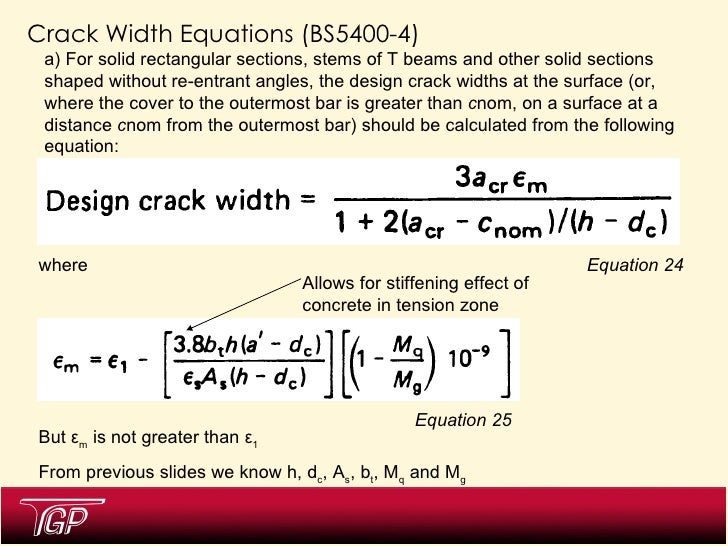Crack Width Calculation Euro Code 2

Eurocode 2: Crack width calculation; FREE VERSION OF RCsolver - Concrete Design with EC2, EC8, and ACI 318. Crack Control according to Eurocode 2. CRACK WIDTH CALCULATIONS ACCORDING TO EUROCODE 2. Eurocode 2 (EN1992-1-1) proposes equations for the calculation of crack width, taking into account several. Crack width evaluation for flexural RC. How can the answer be improved?
Eurocode - Calculation of Crack Width (Urgent)
Eurocode - Calculation of Crack Width (Urgent)
Creep Coefficient Eurocode 2
I am designing a pumping station (water retaining structure) and I found difficulties in complying with the crack width requirement in eurocode based on the forces I obtained from my structural analysis, and I got a few questions regarding the procedures to calculate the design crack width in accordance with the Eurocode BSEN1992-1-1:2004 & BSEN1992-3 & CIRIAC660.
1. According to BSEN1992-3 Cl.7.3.1, If I am designing for a beam (300mmx400mm) in the substructure (tightness class 1, max water depth 3.9m), is that means the allowable crack width of the beam shall be limited to wk1 = 0.16mm (as hd/h = 3.9m/Min(300mm,400mm)= 13). And same shall apply to the column (400x400mm), ( hd/d = 3.9m/400mm = 9.75)?
2. According to Eq.3.13 in CIRIAC660, I could calculate the crack width due to thermal & shrinkage, but shall I combine it with the flexural crack width calculated from Eqt. 7.9 in BSEN1992-1-1:2004 to check against the allowable crack width limit (0.16mm)? Or the design will be OK if the two resulted crack width satisfy the limit individually.
3. According to 7.3.3(2) in Eurocode BSEN1992-1-1:2004, the crack control shall deem to be OK if either the maximum bar diameter or maximum bar spacing are satisfied, and direct calculate of the crack width is not required. But does it only refer to flexural crack width? Shall I still need to calculate and check the thermal & shrinkage crack width if those crack are expected to occur?
Sorry for my poor English and I have attached my design spreadsheet for your checking.
Many Thanks!!!!!!!!!!!
1. According to BSEN1992-3 Cl.7.3.1, If I am designing for a beam (300mmx400mm) in the substructure (tightness class 1, max water depth 3.9m), is that means the allowable crack width of the beam shall be limited to wk1 = 0.16mm (as hd/h = 3.9m/Min(300mm,400mm)= 13). And same shall apply to the column (400x400mm), ( hd/d = 3.9m/400mm = 9.75)?
2. According to Eq.3.13 in CIRIAC660, I could calculate the crack width due to thermal & shrinkage, but shall I combine it with the flexural crack width calculated from Eqt. 7.9 in BSEN1992-1-1:2004 to check against the allowable crack width limit (0.16mm)? Or the design will be OK if the two resulted crack width satisfy the limit individually.
3. According to 7.3.3(2) in Eurocode BSEN1992-1-1:2004, the crack control shall deem to be OK if either the maximum bar diameter or maximum bar spacing are satisfied, and direct calculate of the crack width is not required. But does it only refer to flexural crack width? Shall I still need to calculate and check the thermal & shrinkage crack width if those crack are expected to occur?
Sorry for my poor English and I have attached my design spreadsheet for your checking.
Many Thanks!!!!!!!!!!!
Maximum Bar Spacing for Crack Control - Eurocode 2
Maximum Bar Spacing for Crack Control - Eurocode 2
Hi,
Does any of you have an idea how the values from Table 7.3N: Maximum bar spacing for crack control found in Eurocode 2 were derived?
As shown on the table, the assumption for concrete cover is 25mm but I would like to create a new table for 50mm.
The parameters used and the assumptions given were not enough to solve the values using the crack width calculation in Sec. 7.3.4.
Thanks in advance!
Does any of you have an idea how the values from Table 7.3N: Maximum bar spacing for crack control found in Eurocode 2 were derived?
As shown on the table, the assumption for concrete cover is 25mm but I would like to create a new table for 50mm.
The parameters used and the assumptions given were not enough to solve the values using the crack width calculation in Sec. 7.3.4.
Thanks in advance!